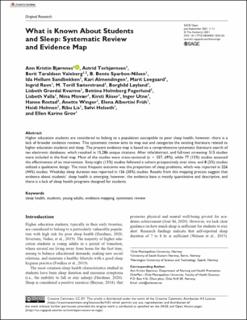What is Known About Students and Sleep: Systematic Review and Evidence Map
Bjørnnes, Ann Kristin; Torbjørnsen, Astrid; Valeberg, Berit Taraldsen; Sparboe-Nilsen, Bente; Sandbekken, Ida Hellum; Almendingen, Kari; Leegaard, Marit; Ravn, Ingrid Helen; Sæterstrand, Torill Margaret; Løyland, Borghild; Kvarme, Lisbeth Gravdal; Holmberg Fagerlund, Bettina; Valla, Lisbeth; Misvær, Nina; Riiser, Kirsti; Utne, Inger; Rostad, Hanne Marie; Winger, Anette; Albertini Früh, Elena; Holmen, Heidi; Ribu, Lis; Helseth, Sølvi; Grov, Ellen Karine
Journal article, Peer reviewed
Published version
Permanent lenke
https://hdl.handle.net/11250/2765610Utgivelsesdato
2021Metadata
Vis full innførselSamlinger
Originalversjon
Bjørnnes, A. K., Torbjørnsen, A., Valeberg, B. T., Sparboe-Nilsen, B. B., Sandbekken, I. H., Almendingen, K., Leegaard, M., Ravn, I., Sæterstrand, M. T., Løyland, B., Kvarme, L. G., Fagerlund, B. H., Valla, L., Misvær, N., Riiser, K., Utne, I., Rostad, H., Winger, A., Albertini Früh, E., Holmen, H., Lis, R., Helseth, S., & Grov, E. K. (2021). What is Known About Students and Sleep: Systematic Review and Evidence Map. Sage Open, 11(3), 21582440211032162. https://doi.org/10.1177/21582440211032162Sammendrag
Higher education students are considered to belong to a population susceptible to poor sleep health; however, there is a lack of broader evidence reviews. This systematic review aims to map out and categorize the existing literature related to higher education students and sleep. The present evidence map is based on a comprehensive systematic literature search of ten electronic databases, which resulted in 15,286 unique citations. After title/abstract, and full-text screening: 515 studies were included in the final map. Most of the studies were cross-sectional (n = 357, 69%), while 77 (15%) studies assessed the effectiveness of an intervention. Sixty-eight (13%) studies followed a cohort prospectively over time, and 8 (2%) studies utilized a qualitative design. The most frequent outcome was the proportion of sleep problems, which was reported in 226 (44%) studies. Weekday sleep duration was reported in 156 (30%) studies. Results from this mapping process suggest that evidence about students` sleep health is emerging; however, the evidence base is mostly quantitative and descriptive, and there is a lack of sleep health programs designed for students.

